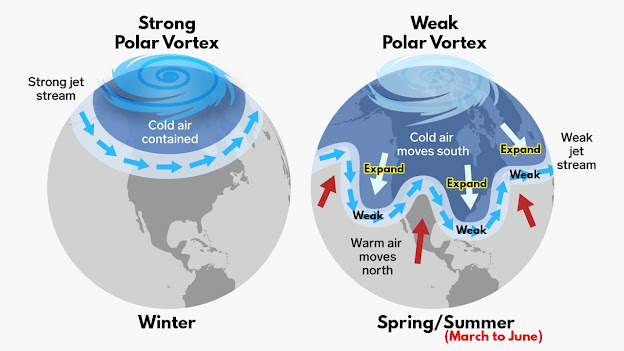What is Polar Vortex?
It is described as a whirling cone of low pressure over the poles that is strongest in the winter months due to the increased temperature contrast between the polar regions and the mid-latitudes, such as the US and Europe.
The polar vortex spins in the stratosphere, a layer of the atmosphere 10-48 km above the ground and above the troposphere, where most familiar weather patterns develop.
STRONG & WEAK POLAR VORTEX
Often when the polar vortex is strong, temperatures are mild in the mid-latitudes across the Eastern US and Northern Eurasia; and when the vortex is weak, temperatures tend to be cold across the Eastern US and northern Europe and Asia.
Strong Polar Vortex
A strong polar vortex is the more common state of the vortex which creates strong low pressure in the Arctic region.
Because of the pressure difference between the Arctic and mid-latitudes, air fl ows into low pressure and this confines the cold air to high latitudes closer to the Arctic. Therefore it is often mild across the Eastern US, Europe, and East Asia during winters when the polar vortex is strong.
During strong polar vortex, the airflow is fast and in a direction from west to east.Low pressure in the Arctic region is referred to as the positive phase of the Arctic Oscillation (AO), which is also known as the North Atlantic Oscillation (NAO).
Weak polar vortex
Occasionally, the polar vortex is disrupted and weakens, due to wave energy propagating upward from the lower atmosphere.
When this happens, the stratosphere warms sharply in an event known as sudden stratospheric warming, in just a few days, miles above the Earth’s surface.
The warming weakens the polar vortex, shifting its location somewhat south of the pole or, in some instances, ‘splitting’ the vortex up into ‘sister vortices’.
The split higher up in the atmosphere can give rise to both, sudden and delayed effects, much of which involves declining temperatures and extreme winter weather in the eastern US along with northern and western Europe.
Sudden stratospheric warming also leads to the warm Arctic not only in the stratosphere but also in the troposphere as well.
A warmer Arctic, in turn, favours more severe winter weather in the Northern hemisphere mid-latitudes including the eastern US.



Comments
Post a Comment